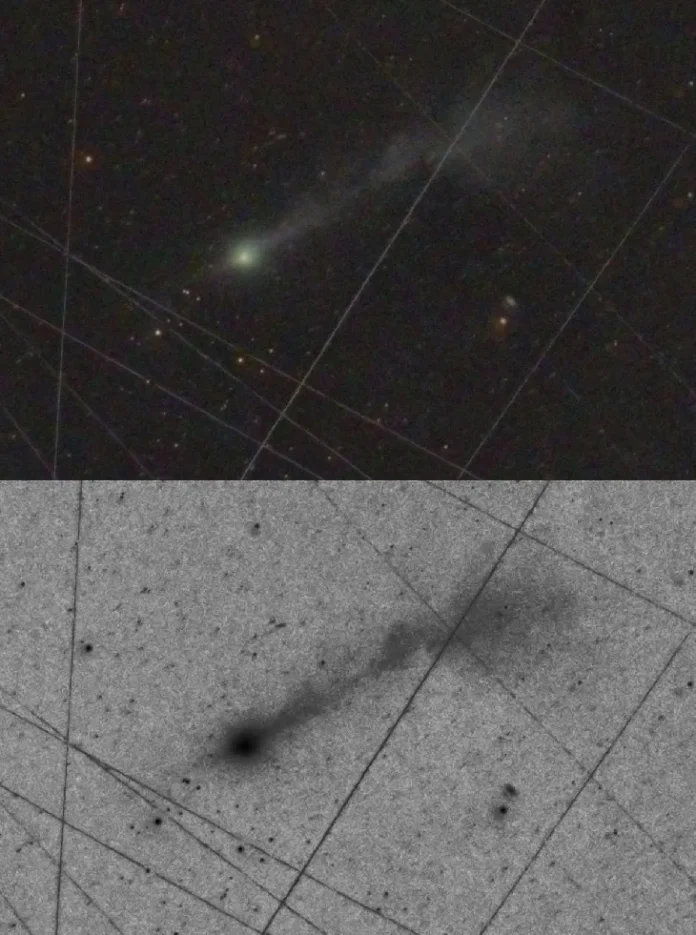
What They’re Not Telling You
- Harvard astrophysicist Avi Loeb reports that new telescope observations reveal the interstellar object 3I/ATLAS ejecting material across distances three times wider than the Sun, with mass-loss rates that challenge conventional comet physics.
- The object’s combination of extreme size, retrograde trajectory alignment, and energetic jet behavior yields odds of one in a hundred million against random natural occurrence.
- Spectroscopic observations planned for its December 19, 2025 closest approach to Earth will determine whether the jets originate from sublimating ice or represent technology-driven propulsion.
By Samuel A. Lopez | USA HERALD
On November 9, 2025, astronomers Frank Niebling and Michael Buchner captured stacked telescope images showing 3I/ATLAS producing two jets extending toward the Sun across 950,000 kilometers of space, accompanied by a longer collimated jet stretching 2.85 million kilometers in the opposite direction.
The scale dwarfs previous observations by three orders of magnitude compared to the Hubble Space Telescope’s July imaging of the object’s glowing halo.
At 3I/ATLAS’s current distance of 326 million kilometers from Earth, the visible jet structure represents material ejected over periods of one to three months. For natural comets at this solar distance, gas outflow velocities reach only 0.4 kilometers per second, roughly the speed of sound in solar-heated gas.
The jets’ ability to extend nearly one million kilometers against solar wind pressure indicates their outermost mass density exceeds ambient conditions by a factor of one million, with the anti-tail jets maintaining structural integrity where typical comet material would disperse.
Loeb’s calculations based on the observed jet dimensions and required ram pressure yield a mass-loss rate of 50 billion tons per month. This figure approaches the minimum estimated mass of 3I/ATLAS itself, which Loeb previously calculated at 33 billion tons based on the object’s lack of non-gravitational acceleration before October 2025.
The mass comparison exposes what Loeb identifies as the primary anomaly. The inferred mass of 3I/ATLAS exceeds that of 1I/Oumuamua, the first confirmed interstellar visitor discovered in 2017, by at least one million times. Statistical models of interstellar rocky material distribution predict that detecting an object 10 kilometers or larger should occur once per ten thousand years or longer, not as the third interstellar detection within a decade-long survey period.
The probability of encountering such a massive object this early stands at less than 0.1 percent if all interstellar material exists in large bodies, dropping to 0.0005 percent under standard mass distribution models.
Compounding the statistical improbability, 3I/ATLAS follows a retrograde orbit aligned within five degrees of the ecliptic plane, an orientation occurring in only 0.2 percent of random trajectories. The combined odds of both characteristics appearing together in a natural interstellar comet reach one in one hundred million.
The analysis introduces an alternative framework. Chemical rocket exhaust velocities of three to five kilometers per second exceed natural comet outgassing speeds by a factor of ten, reducing required propellant mass proportionally.
Avi Loeb’s analysis points out that Ion thrusters achieve 10 to 50 kilometers per second, cutting mass requirements by additional factors. If 3I/ATLAS employs propulsion technology with velocities two orders of magnitude above natural processes, the fuel mass could represent less than one percent of the spacecraft’s total mass rather than consuming the entire object.
The solar wind at 3I/ATLAS’s location flows at 400 kilometers per second, one thousand times faster than natural comet outflows. Because ram pressure scales with velocity squared, the jets must carry mass density one million times greater than the solar wind’s few protons per cubic centimeter to maintain their observed structure.
This mass flux of two million kilograms per second per million-kilometer square, integrated across the jet’s cross-sectional area, drives the 50-billion-ton monthly mass loss calculation.
NASA’s Juno spacecraft orbiting Jupiter will pass within 53 million kilometers of 3I/ATLAS on March 16, 2026, while ESA’s Juice spacecraft currently maintains a separation of 64 million kilometers. Both distances exceed the current jet structure extent by an order of magnitude, preventing direct particle collection.
Earth-based satellites face similar limitations at the December closest approach distance of 269 million kilometers, roughly 100 times the jet’s spatial scale.
The December 19, 2025 closest approach presents the optimal window for spectroscopic observations using the Hubble and Webb space telescopes. These instruments can measure jet velocity, composition, and mass flux directly. Chemical signatures will distinguish between water ice, carbon dioxide, and other volatiles expected from natural comets versus potential propellant signatures.
Velocity measurements will confirm whether material travels at the 0.4 kilometers per second characteristic of sublimation or at the multi-kilometer-per-second speeds associated with directed thrust.
Loeb frames the investigation as requiring scientific humility rather than presumptive conclusions, but clearly points to the statistical anomalies and physical characteristics that warrant consideration of non-natural origins.


